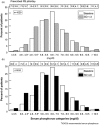Real-world effectiveness of sucroferric oxyhydroxide in patients on chronic hemodialysis: A retrospective analysis of pharmacy data
- PMID: 28587714
- PMCID: PMC5514614
- DOI: 10.5414/CN109021
Real-world effectiveness of sucroferric oxyhydroxide in patients on chronic hemodialysis: A retrospective analysis of pharmacy data
Abstract
Aims: Hyperphosphatemia has been associated with an increased risk of mortality in patients with end-stage renal disease. We sought to assess the real-world effectiveness of sucroferric oxyhydroxide (SO), an iron-based phosphate binder (PB), in control of serum phosphorus levels, and to determine the associated pill burden in hemodialysis patients.
Materials and methods: Adult, in-center hemodialysis patients first prescribed SO through a renal pharmacy service as part of routine clinical care between April 1, 2014 and March 31, 2015 were included in the analysis. The proportion of patients with phosphorus levels ≤ 5.5 mg/dL and the mean prescribed PB pills/day were compared between baseline (3 months prior to SO) and SO follow-up at 3 (SO 1 - 3) and 6 months (SO 4 - 6). Mineral bone disease markers, hemoglobin, iron indices, and erythropoiesis-stimulating agents and intravenous iron use were assessed.
Results: At baseline, all patients (n = 1,029) were prescribed PB, and 13.9% had mean serum phosphorus ≤ 5.5 mg/dL. Comparing baseline to SO 1 - 3, the mean prescribed PB pills/day declined from 9.6 to 3.8 pills/day (p < 0.001), and the proportion of patients with serum phosphorus ≤ 5.5 mg/dL increased from 13.9 to 26.1% (+88%). Comparing baseline to SO 4 - 6 (n = 424), the mean prescribed PB pills/day declined from 9.7 to 4.0 pills/day (p < 0.001), and the proportion of patients with serum phosphorus ≤ 5.5 mg/dL increased from 15.6 to 30.4% (+95%).
Conclusions: Prescription of SO was associated with an increase in the proportion of patients achieving serum phosphorus levels ≤ 5.5 mg/dL along with fewer prescribed PB pills/day. .
Figures



Similar articles
-
Management of serum phosphorus over a 1-year follow-up in patients on peritoneal dialysis prescribed sucroferric oxyhydroxide as part of routine care: a retrospective analysis.BMC Nephrol. 2024 Jun 17;25(1):197. doi: 10.1186/s12882-024-03633-8. BMC Nephrol. 2024. PMID: 38886636 Free PMC article.
-
The real-world effectiveness of sucroferric oxyhydroxide in European hemodialysis patients: a 1-year retrospective database analysis.BMC Nephrol. 2020 Dec 7;21(1):530. doi: 10.1186/s12882-020-02188-8. BMC Nephrol. 2020. PMID: 33287733 Free PMC article.
-
Real-World Scenario Improvements in Serum Phosphorus Levels and Pill Burden in Peritoneal Dialysis Patients Treated with Sucroferric Oxyhydroxide.Am J Nephrol. 2018;47(3):153-161. doi: 10.1159/000487856. Epub 2018 Mar 7. Am J Nephrol. 2018. PMID: 29514139 Free PMC article.
-
Sucroferric oxyhydroxide for hyperphosphatemia: a review of real-world evidence.J Nephrol. 2022 Apr;35(3):875-888. doi: 10.1007/s40620-021-01241-5. Epub 2022 Feb 9. J Nephrol. 2022. PMID: 35138627 Free PMC article. Review.
-
Sucroferric oxyhydroxide for the treatment of hyperphosphatemia.Expert Opin Pharmacother. 2018 Jul;19(10):1137-1148. doi: 10.1080/14656566.2018.1491548. Epub 2018 Jul 9. Expert Opin Pharmacother. 2018. PMID: 29985725 Review.
Cited by
-
Serum Phosphorus and Pill Burden Among Hemodialysis Patients Prescribed Sucroferric Oxyhydroxide: One-Year Follow-Up on a Contemporary Cohort.Int J Nephrol Renovasc Dis. 2022 Apr 11;15:139-149. doi: 10.2147/IJNRD.S353213. eCollection 2022. Int J Nephrol Renovasc Dis. 2022. PMID: 35431567 Free PMC article.
-
Phosphate binder pill burden, adherence, and serum phosphorus control among hemodialysis patients converting to sucroferric oxyhydroxide.Int J Nephrol Renovasc Dis. 2019 Jan 22;12:1-8. doi: 10.2147/IJNRD.S182747. eCollection 2019. Int J Nephrol Renovasc Dis. 2019. PMID: 30774412 Free PMC article.
-
Changes in serum albumin and other nutritional markers when using sucroferric oxyhydroxide as phosphate binder among hemodialysis patients: a historical cohort study.BMC Nephrol. 2019 Oct 29;20(1):396. doi: 10.1186/s12882-019-1582-9. BMC Nephrol. 2019. PMID: 31664928 Free PMC article.
-
Management of serum phosphorus over a 1-year follow-up in patients on peritoneal dialysis prescribed sucroferric oxyhydroxide as part of routine care: a retrospective analysis.BMC Nephrol. 2024 Jun 17;25(1):197. doi: 10.1186/s12882-024-03633-8. BMC Nephrol. 2024. PMID: 38886636 Free PMC article.
-
Intestinal Chelators, Sorbants, and Gut-Derived Uremic Toxins.Toxins (Basel). 2021 Jan 26;13(2):91. doi: 10.3390/toxins13020091. Toxins (Basel). 2021. PMID: 33530404 Free PMC article. Review.
References
-
- Eknoyan G Levin A Levin NW K/DOQI clinical practice guidelines for bone metabolism and disease in chronic kidney disease. Am J Kidney Dis. 2003; 42: S1–S201. - PubMed
-
- United States Renal Data System. 2015 USRDS annual data report: Epidemiology of Kidney Disease in the United States. National Institutes of Health, National Institute of Diabetes and Digestive and Kidney Diseases, Bethesda, MD. 2015.
MeSH terms
Substances
LinkOut - more resources
Full Text Sources
Other Literature Sources
Medical
Miscellaneous

